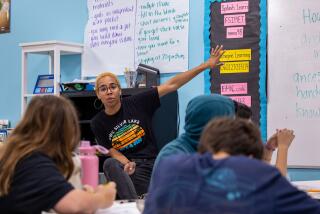Teaching Their Teachers : San Diego Sixth-Graders Write the Book on Methods That Work in Class
SAN DIEGO â The next time teachers scour the literature for ways to help their students learn, they might want to pick up a new book written by students for teachers.
If they do, theyâll find out about Starburst math, about the Rainbow Handwriting Award, about Max and E.T., the Minute of Silence and a host of other tricks, activities and strategies that the students âbattle-testedâ--with the result that they study more and enjoy education more.
The book, âSchool Our Way,â is a product of teacher Rick Morrisâs sixth-grade class at Sequoia Elementary School in Clairemont and will be on sale for $3 this week at the annual Mentor Teachers Conference in downtown San Diego.
In its introduction, the class says its illustrated guide is chock-full of â20 terrific techniques for a happier, more productive class.â
As part of a two-month writing project, the students picked their favorites from the many ideas that Morris uses to create a more exciting class. Those ideas are geared toward involving students in routine teacher chores as well as stimulating them to go beyond the rote recitation still common in many schools.
Not many classrooms, for example, feature âEducational Reserve Notesâ in the form of paper money--with Morrisâ picture smack in the middle--which students receive for a chore well done or an answer well reasoned. The ânotesâ are redeemable in a student-run classroom store for snacks or supplies.
Nor do most classes have a âCome-and-Get-It-Chuck-Wagon!â music triangle that students clang anytime a peer is reading aloud with too little expression.
Morris, well known among county educators for the enthusiasm and creativity he brings to teaching, has long wanted to write a book about all the classroom management techniques he has cooked up for children over the years and presented at teacher training seminars.
âWhy not have the students do it?â Morris asked. âAfter all, they can tell you what really works and what doesnât.â
The bookâs selections include the simple, such as âMax,â the name given to the class digital timer they use instead of classroom clocks, which are broken most of the time.
Then thereâs Starburst math, named after the popular candy. The teacher dons a white lab coat with a fistful of Starburst squares in the right pocket and a name tag on the lapel--except that in place of a name, thereâs a math problem drawn in bright colors.
The teacher, transformed into âDr. Starburst,â solicits students to come up with an answer and gain a candy reward.
The book even promotes âClassroom Clean-Up.â Student Richard Padilla explains: âThereâs a jar full of jobs written on paper that are handed out randomly and which we have three minutes to do. . . . Itâs our way of helping out the custodian.â
Morris is a legend among Sequoia students for his energy, his excitement and his caring attitude.
âHeâs firm but he doesnât ever raise his voice,â student Mario Vazquez said. Mike Fisher added: âWe learn a lot of stuff without just using our books.â
Morris used the book-writing project to push creative thinking, writing, cooperative learning and art into one integrated learning project.
âEarly on I picked âMaxâ as an example for students to think about how to describe,â Morris said. âWe talked about it for a while, then I gave everyone 20 minutes to write down their thoughts.â
Morris took the papers home, made notes for the students and solicited a student editor who had turned in a colorful description for that chapter. That student was paired with a classmate to look over all the papers and come up with a final version.
âOverachiever, underachiever, it doesnât matter,â Morris said. âThe key is to get kids involved, to give them power in a positive sense, because otherwise theyâll grab on to negative power.â
Morris had the final product copyrighted and printed using his desktop publishing system.
For Morris, the only real surprise came in looking over some of the studentsâ selections, such as âClay Sculpting.â Itâs an idea thatâs new this year to mesh art, listening and creativity. While students work with modeling clay in the afternoon, Morris reads aloud from a novel.
Morris wasnât sure how it would go over. The class embraced it.
âThe purpose is to see how creative you can be as you listen to a story,â students wrote. âAfter we are finished, we walk around the room to see what other students have created.â
Morris said, âThat (inclusion) was great for me because it shows that students really can pick up on the fun of learning.â
More to Read
Sign up for our Book Club newsletter
Get the latest news, events and more from the Los Angeles Times Book Club, and help us get L.A. reading and talking.
You may occasionally receive promotional content from the Los Angeles Times.









